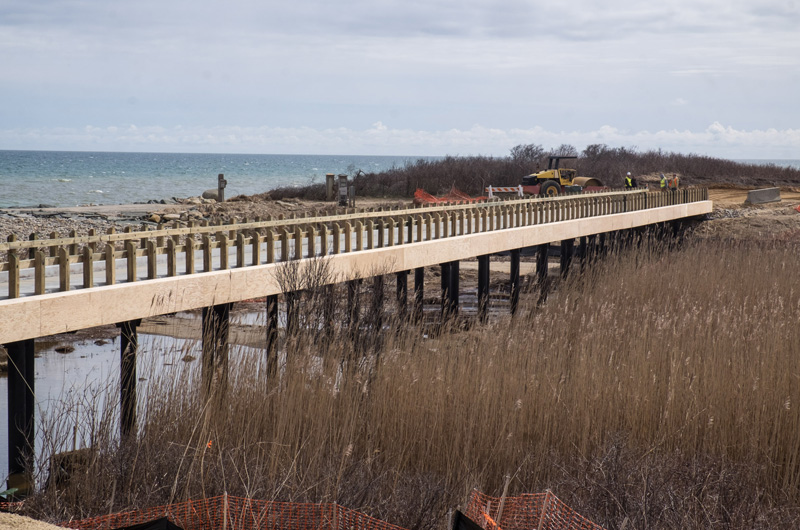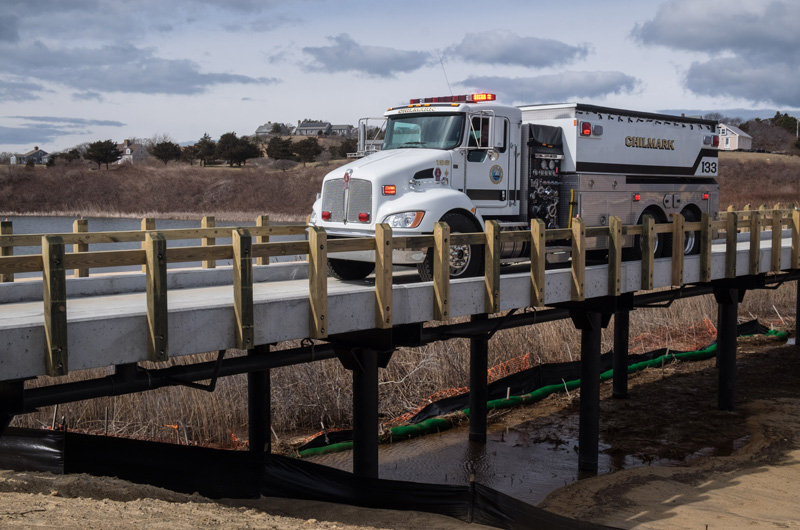After weeks of storm delays, the first chunks of rocks and cement were clawed out of the earth at Squibnocket Beach Monday morning to start the public portion of the public-private Squibnocket project that has weathered numerous legal battles since its inception.
For the private portion of the project, a 300-foot raised causeway was recently completed to provide access to Squibnocket Farm, a 14-home private enclave.
Years of erosion exacerbated by Hurricane Sandy in 2005 have caused the shoreline to migrate north. High tide now reaches the parking lot that contained the only access road to Squibnocket Farm, just 10 feet above sea level.
The public portion of the project involves managing the erosion of the town beach by removing the revetment, tearing out the current parking lot and building a new one 100 feet farther up the bank to Squibnocket Pond.
The cost of the town portion of the construction project is approximately $440,000, according to town conservation agent Chuck Hodgkinson.
Mr. Hodgkinson said last month the town received a state grant from the Massachusetts Office of Energy and Environmental Affairs that will reimburse the town $199,550 for the project.
Revetment removal could not start until the causeway was completed. The removal was set to begin two weeks ago, but the crashing waves from the recent span of northeasters made the work impossible, according to beach project contractor John Keene.
With another storm possibly arriving Wednesday night, Mr. Keene said the two-week delayed project can’t afford to wait any longer.
“We’re going to start cautiously taking things apart since we know a storm is coming,” he said. “It’s a vulnerable situation, but we can’t not do it.”
Erosion from the last two storms has caused the revetment to slump and fall into the water, according to Mr. Keene. He said huge breaking waves from the storms hammered the embankment and moved rocks and concrete up onto the parking lot.
Mr. Hodgkinson added that waves swept underneath the roadway running from the parking lot to the security gate, revealing a sinkhole.
“It’s been a recurring battle,” Mr. Keene said.
He said once the revetment is removed and the concrete is dug out of the parking lot, then 3,500 yards, or 2,600 tons, of sand dredged from the Menemsha Channel will be dumped onto the lot to make a sand dune. Over time, he said nature will take its course and the sand will round out the beach.

The project has faced several legal challenges from a neighbor group led by Blacksmith Valley resident Doug Liman that has attempted to block the project in court.
An injunction filed by the group was denied in state land court last month, likely defeating any last chance of the group blocking the build.
Chilmark selectmen Jim Malkin told the Gazette that the project is moving forward, with only nature slowing it down now.
“I would hope that he is not interested to continue his appeal,” Mr. Malkin told the Gazette by phone, referring to Mr. Liman.
Mr. Malkin couldn’t provide an exact figure on how much the town has paid in legal fees to defend the project, but he said town counsel has spent considerable time on the issue.
Once the public portion of the project is complete, Mr. Hodgkinson said Squibnocket Beach will include an additional 1,000 feet of beach west to the mussel bed.
He said the new, nearly 50-space parking lot will include a cul-de-sac for buses to turn around and handicap spots that won’t require residents to go down stairs to get to the beach. There will no longer be a road going through the parking lot for homeowners.
The next project deadline is April 15 for the planting beach grass. The hard deadline to finish removing the revetment and completing the new parking lot is Memorial Day.
“The bottom line is we have deadlines and we’re trying to dance with Mother Nature,” Mr. Keene said. “There are lots of entities and variables involved, and it’s not like no one is watching.”








Comments
Comment policy »